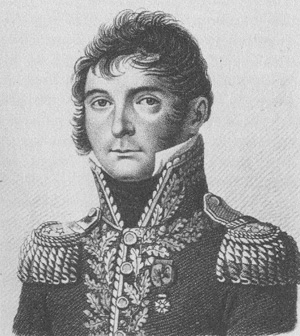General Samuel François L'Héritier

Born: August 6, 1772
Place of Birth: Angles, Vienne, France
Died: August 23, 1829
Place of Death: Conflans-Sainte-Honorine, France
Arc de Triomphe: L'HÉRITIER on the east pillar
Pronunciation:
The son of a notary, Samuel François L'Héritier first joined the army in September of 1792 as a grenadier in the 3rd Battalion of Indre-et-Loire. Assigned to the Army of the Rhine, he became a secretary for the staff of that army in August of 1793. In 1796 L'Héritier was promoted to lieutenant and the following year he became an aide-de-camp to General Bellavène. In October of 1797 he received a promotion to capitaine. By the year 1800 L'Héritier had joined the staff of General Boudet and in this position he fought at Marengo where he was wounded in the thigh. Later that year he became an aide-de-camp to General Laboissière and then in 1801 he received a promotion to chef d'escadrons. In 1803 L'Héritier joined the 11th Cuirassiers and he served with them during the campaign of 1805 against Austria.
In October of 1806, just before the start of the campaign against Prussia that year, L'Héritier was promoted to colonel of the 10th Cuirassiers. Serving as part of d'Hautpoul's division, he led his men into battle at Eylau in February of 1807 and was again wounded, this time to the right hand. The next year he was created a Baron of the Empire. L'Héritier's next major action came when he and his men took part in the Danube campaign of 1809. That May he fought at Aspern-Essling where he was wounded by a shot to the right shoulder, and then in July he fought at Znaim where he was wounded by a blow to the head. Within a few weeks, L'Héritier was promoted to général de brigade and shortly thereafter he took command of the 2nd Brigade of the 3rd Division of Cuirassiers.
In 1811 L'Héritier served as an inspector of depots of cavalry before rejoining the 2nd Brigade of the 3rd Division of Cuirassiers. As part of Doumerc's division, in 1812 he and his men served throughout the campaign in Russia as part of II Corps. During that campaign he distinguished himself at the Second Battle of Polotsk . March of 1813 saw L'Héritier promoted to général de division and he served in Saxony during the campaigns of that year. That July he was given command of the 4th Heavy Cavalry Division in III Corps and in August he fought at the combat of Giesshubel. In October L'Héritier took over the 5th Heavy Cavalry Division under General Pajol and then in October he and his men defended the Rhine against the cossacks.
For the defense of France of 1814, General L'Héritier again led a heavy cavalry division. That January he served at Brienne and then in February he fought at Villeneuve, Valjouan, and Troyes. In March L'Héritier fought at Saint-Dizier before Napoleon ultimately abdicated in April. The returning Bourbons put L'Héritier on half pay but also made him a Knight of Saint Louis and Commander of the Legion of Honor. At the end of the year he was named inspector general of cavalry for the 16th military division.
When Napoleon returned from exile on Elba in 1815 for the Hundred Days, L'Héritier rallied to him. L'Héritier was given command of the 11th Cavalry Division in Kellermann's III Cavalry Corps. He led his men on the campaign that June and fought at the Battle of Waterloo where he was wounded by a shot to the right shoulder. After Napoleon's second abdication, L'Héritier was put on non-activity. In 1819 he was back in good graces and actively employed in the French military again as an inspector general of cavalry.
Bibliography
- Divry, Arnauld. Les Noms Gravés sur l'Arc de Triomphe. Paris: L'Harmattan, 2017.
- Six, Georges. Dictionnaire Biographique des Généraux & Amiraux Français de la Révolution et de l'Empire (1792-1814). 2 vols. Paris: Gaston Saffroy, 2003.
Updated March 2023
© Nathan D. Jensen